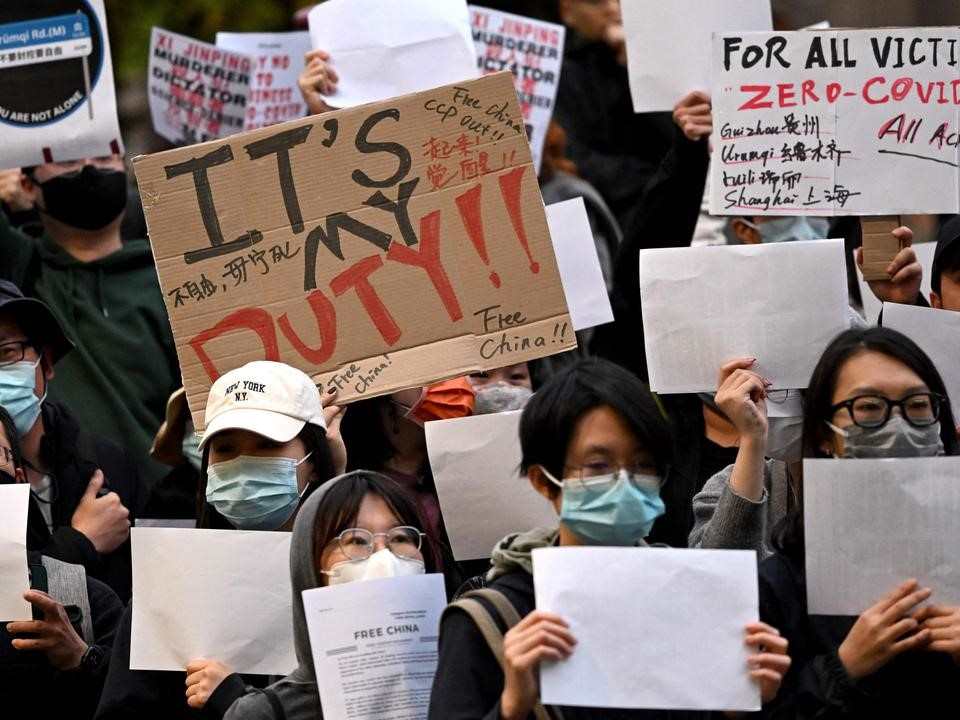The last months of 2022 have seen historical protests in China, led by thousands of students, residents and Chinese citizens criticising Xi Jinping’s handling of the continued COVID-19 crisis still affecting China to this day.
These protests are unprecedented in their claims: nation-wide protests are rare in China but the fact that the protestors are calling for Xi to step down and for the CCP to leave is historic. Protests on the streets have sparked up all over the country: Urumqi, Shanghai, Beijing, Zhuzhou, the universities of Tsinghua and Beida and many more. Chants of ‘end the lockdown’ or ‘give me liberty or give me death’ echo the Chinese national anthem sung in all parts of the country: ‘rise up, those who refuse to be slaves’.
The CCP and Xi Jinping have enforced a strict culture of censorship eliminating any dissent. Public discussion and forum take place on Chinese social media platforms (Weibo, Douyin or Wechat) which are controlled and silenced, flooded by neutral and safe posts to drown out the complaints of food and medication shortage. Thus, the population has had to resort to creative solutions to protest. In the current wave of anger, demonstrators have been using a white sheet of paper to manifest their discontent, symbolising the desire for change but also representing the all-encompassing censorship. Protests against the sanctions and measures taken by the government against COVID are symptoms of the larger culture of repression and censorship at the heart of the CCP to control China. Policemen have been controlling smartphones in Shanghai and law enforcement officers are equipped with hi-tech surveillance and facial recognition which, combined with AI software, can run through protest footage to find, and identify dissenters. This is all part of the ‘highest emergency response level’ deployed to deal with the protests; this includes crackdown on VPN’s and tracking online presence. Xi Jinping is at the head of a nation-wide apparatus that controls state media, censorship, propaganda, army, and national surveillance which makes these recent protests all the more courageous and daring.
Cases are rising exponentially as we have seen in the past week as China has broken its Zero COVID policy. Why then is the population still protesting and why is this a historic phenomenon?
The latest protests started in late October, mainly calling for the end of the Zero-COVID policy, fuelled by tragic incidents such as an overturned bus or an apartment block fire in Urumqi, capital of Xinjiang, with a death toll of 10. Due to the Covid measures, the fire-trucks were unable to get to the scenes and prevent the fire. Xi Jinping endorsed and pushed a policy of extreme measures taken to ensure low rates of contagion and disease-spread which did ensure two years that were largely virus free. Nevertheless, instead of expanding and funding the Chinese health care system or accepting global partnerships, Xi Jinping’s government chose to continue to pursue the Zero COVID policy with ferocity.
This has led to increasingly desperate situations and tensions rising as the government pursues, with no break in mind, endless lockdowns, and quarantines. Horror stories of residents locked in their homes, doors nailed shut, pregnant women sent home from hospitals closing and continued denied health care assistance have fuelled the current wave of protests.
All of these protests against the Zero-COVID policy have created a zero-sum game for Xi: either he tightens and conserves the Zero-COVID policy, ignoring the population’s cries for help but continuing an efficacious if temporary COVID policy; or he loosens COVID measures, listens to the population but risks a devastating outbreak. So far, Xi has opted for a two-pronged approach: he has flooded protest sites before crowds could gather, has broken with his favoured Zero Covid and it seems like the government is implementing a policy of intimidation attempting to silence the population all while certain concessions have been made: some controls have been lifted; you can catch a bus, a metro or enter a mall without needing a recent negative PCR test and those exposed may quarantine at home. Nevertheless, this does not signal a new era or a new Xi for that matter: it is simply a question of gaining time and the CCP has made it very clear, historically, that it would have no compunction in using force to repress any and all protests.
What does the future hold for China? First, Xi will have to face the Spring session of the National People’s Congress. Xi will also have to contend with future economic ramifications that the Zero-COVID policy has had on Chinese industry and property: the FMI predicts a growth of 3.2% for the next year for China, well under the CCP’s desired official objective of 5.5%. This shows the disconnect between Xi’s government and the reality that the Chinese population are going through. Growth has indeed slowed as the tech sector has been largely impacted by the US Trump-led trade wars and the Chinese property sector’s crisis is menacing the life-savings of many of the Chinese population. Finally, the Zero-COVID policy has impacted the relationships the ‘world’s workshop’ entertains with international trade and especially European manufacturers: the recent shutdown of the Foxconn factory has allegedly cost Apple a third of its Christmas inventory while Honda has paused production in its Wuhan-based factory. It remains to be seen if this is the start of a wider shift away from Chinese reliance due to supply chain disruptions and COVID-related flare-ups towards other rapidly growing countries such as India or Vietnam.
The protests China has experienced have been historic in scale and in demand: it is the first time a demand for democracy, freedom of speech but most importantly the call for Xi’s resignation and the end of the CCP itself have occurred on such a large scale. While the 2018 March Congress of the CCP effectively terminated all end to Xi’s leadership, his reign has, for the first time in a long time, been widely contested and it remains to be seen whether China has entered a new era or has simply prolonged decades of oppression and censorship.






0 Comments